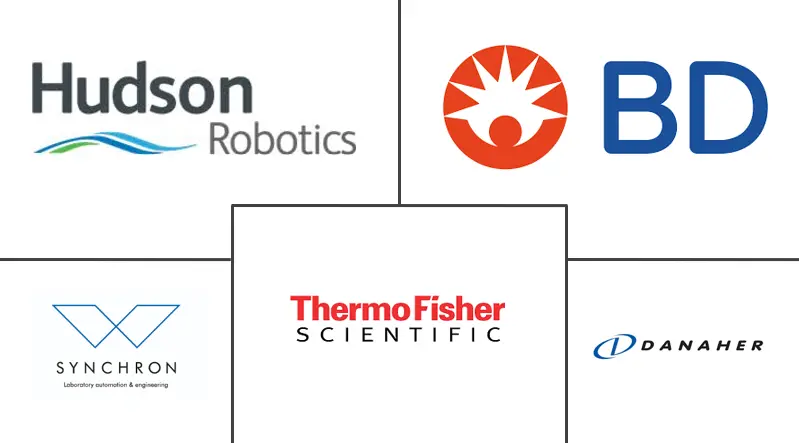Lab Automation In Clinical Diagnostics Market Size and Share
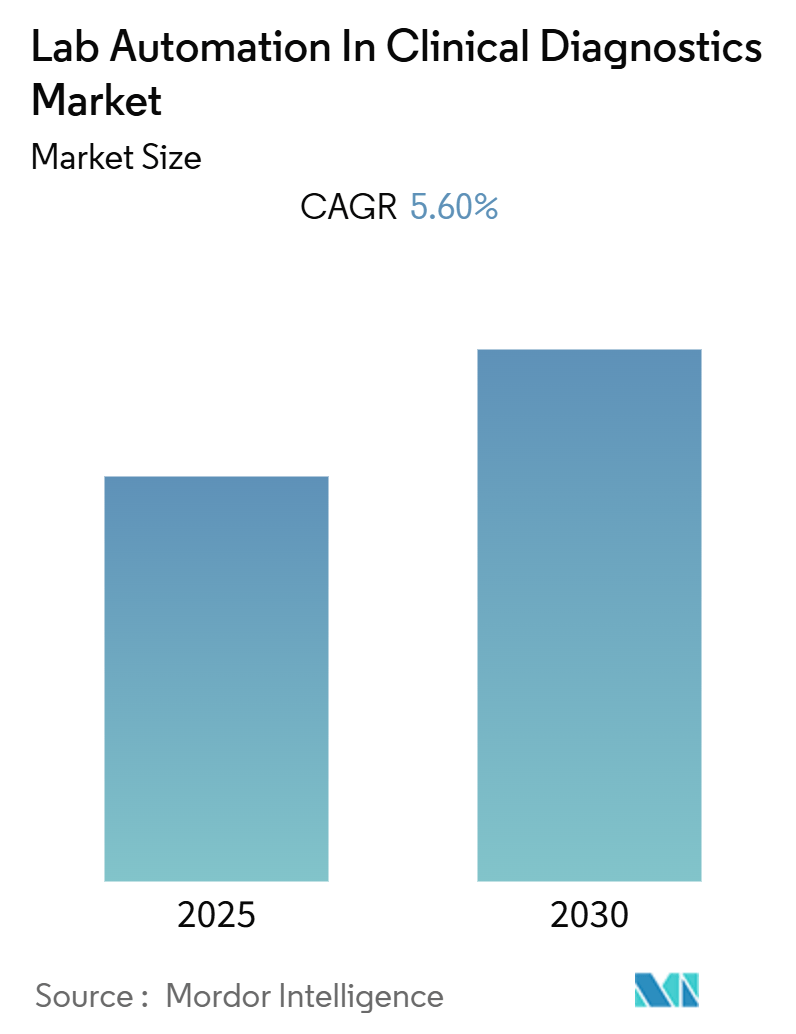
Lab Automation In Clinical Diagnostics Market Analysis by Mordor Intelligence
The Lab Automation In Clinical Diagnostics Market is expected to register a CAGR of 5.60% during the forecast period.
- Across various industries, laboratories are a vital part of manufacturing and scientific research organizations. The primary goal of research and diagnostic labs is to provide high-quality and reliable information, which fulfills the industry's needs. The use of manual systems hampers data quality during the transferring process. The number of medical technicians, the drive to reduce costs, and an increasing need for diagnostic procedures for aging baby boomers, and new testing requirements collectively force the hospital and clinical laboratories to adopt automation equipment.
- Moreover, the rapid spread of existing diseases and discoveries increases the demand for early remedies and diagnoses. This is expected to ascend the rate of clinical diagnostic application, thereby fuelling the incorporation of lab automation equipment and software.
- Major vendors are launching new products to enlarge their product portfolio, which is expected to aid the market's growth over the forecast period. For instance, Beckman Coulter, a prominent vendor in clinical diagnostics, announced that the latest addition to its automation portfolio, the DxA 5000 total laboratory automation solution achieved European CE Mark and China Food and Drug Administration (FDA) approval.
- Laboratories are highly focused on improving patient care by driving faster turnaround time, offering quality results, and enhancing laboratory operations in today's healthcare environment. The solutions, such as DxA 5000, support laboratories worldwide in delivering a highly consistent turnaround time to the physicians. The system leverages dynamic system software and utilizes intelligent routing to bring automated patient-centric workflow to the laboratories. Such integration of solutions to make them more efficient and suit the customization needs through software is expected to drive innovations in the market. By understanding the tests requested, sample volume available, and real-time analyzer capacity and status, these systems continuously calculate the most expeditious route for each sample.
- Further, automation in medical laboratories has been witnessing an increasing trend, including research and diagnostic laboratories, such as clinical chemistry, hematology, and molecular biology. Modular laboratory automation is widely employed in clinical diagnostics for various applications that include sample preparation, distribution, screening, and archiving.
- Moreover, before the pandemic, Shimadzu Scientific Instruments launched the Clinical Laboratory Automation Module (CLAM-2030), a fully integrated sample pretreatment module for LCMS biological analysis. These types of innovation in the market helps in improving the efficiency of laboratories by enabling fast, precise results while maintaining low operating costs.
Global Lab Automation In Clinical Diagnostics Market Trends and Insights
Automated Liquid Handlers is Expected to Hold Significant Market Share
- Liquid handlers are usually employed in biochemical and chemical laboratories. Automated liquid handling robots help in dispensing samples and other liquids in laboratories. Liquid handlers operate via a software controller using an integrated system that customizes the handling procedures with large transfer volumes.
- Automated liquid handlers minimize run times and maximize accuracy. Liquid handlers can operate across many volumes, extending into nanolitres, proving their usefulness in dispensing operations. Leading companies have set the benchmark for the development of automated liquid handlers and are constantly investing in developing premium products to increase productivity effectively.
- Moreover, vendors in the market are innovating products to enhance their product portfolio. For instance, Tecan announced the new Cavro Magni Flex for next-generation automated liquid handling development primarily intended for low to medium throughput workflows for virtually any life sciences application, ranging from immunoassay processing to molecular diagnostics.
- Additionally, advanced liquid handling technologies, such as automated positive displacement pipetting systems, enable users to handle highly viscous to highly volatile liquid types of both lower volume ranges and a wider variety of liquid types. Companies like Beckman Coulter have launched a range of flexible, scalable liquid handling solutions for genomic, cellular, protein, and other workflows. The Biomek 4000 Automated Liquid Handler launched helps standardize daily pipetting routines, maintain sample quality, and generate repeatable, reliable results.
- Furthermore, in January 2020, Hamilton Company announced that its latest automated liquid handling platform, the Microlab Prep, is available through their e-commerce website in the United States and Canada. The compact Microlab Prep provides complete walkaway convenience and effective liquid handling performance in workflows using 96- and 384-well microplates and other sample vessels.
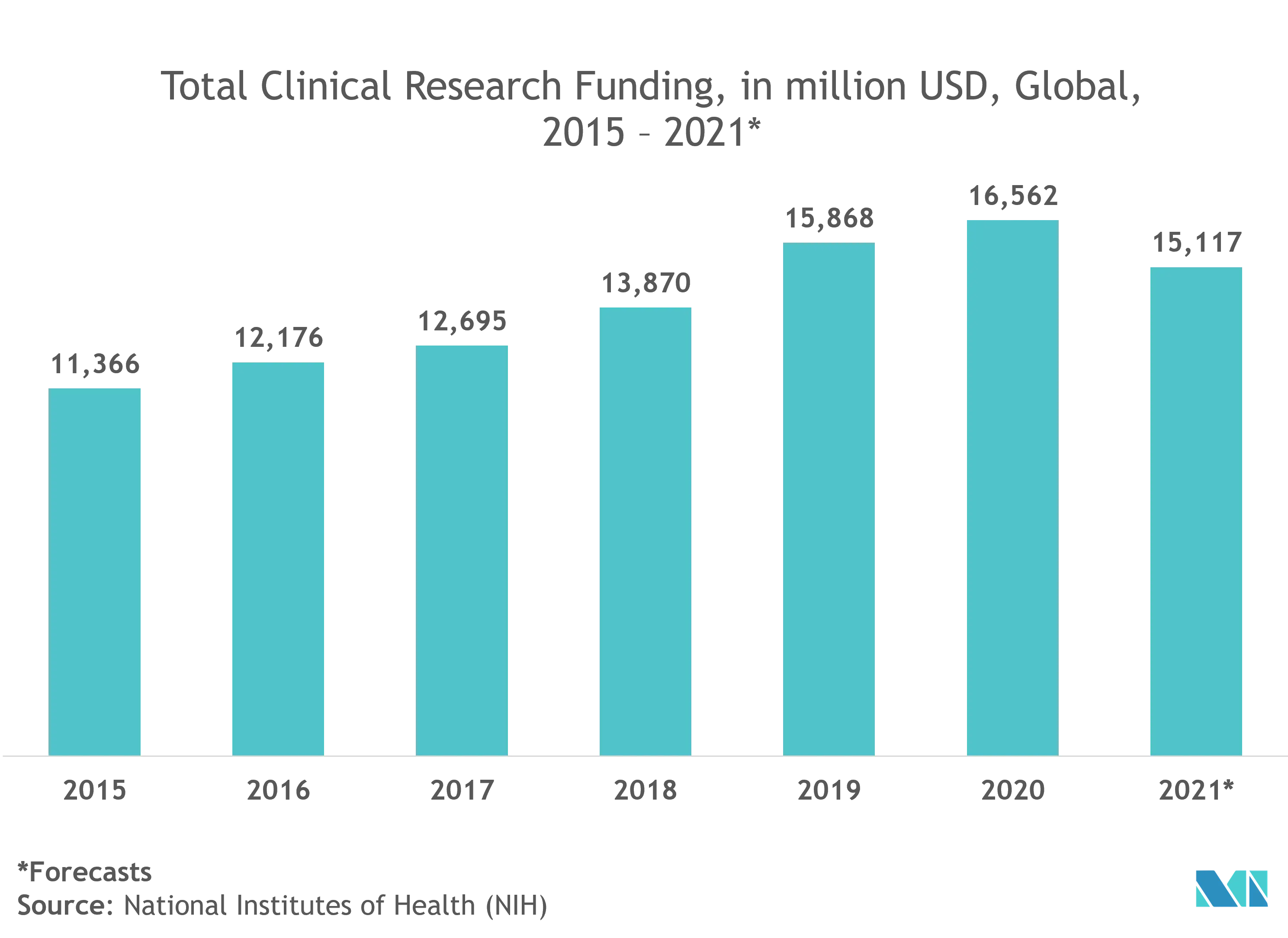
North America Accounts For the Largest Market Share
- North America has been a pioneer in clinical research for years. This region is home to some major pharmaceutical companies, like Pfizer, Novartis, GlaxoSmithKline, J&J, and Novartis. This region has the highest concentration of contract research organizations (CROs). This region's major CROs are Laboratory Corporation of America Holdings, IQVIA, Syneos Health, and Parexel International Corp.
- The inclusion of robotics and automation has been a significant factor aiding the transformation of the clinical research industry. According to the US National Library of Medicine, 98,119 clinical studies were registered in the United States last year. Moreover, there has been a significant rise in the FDA approvals received in the past years, owing to automation.
- This region benefits the most from the proximity of the automation equipment and software providers. With the equipment manufacturers and institutes carrying out a clinical trial, the companies can also achieve a better synchronization to integrate various equipment's, which is the most crucial aspect of process automation.
- Further, Microbiological labs in the region seek technologically innovative solutions to cope with samples and limited personnel resources. Some major manufacturers, such as BD Kiestra and Copan Diagnostics Inc., are commercializing partial or complete lab automation systems for bacteriology in the United States.
- Mayo Clinic's clinical microbiology lab, United States, uses automated blood culture instruments that sense microbial growth in blood culture bottles and mark positive bottles for immediate attention by technologists.
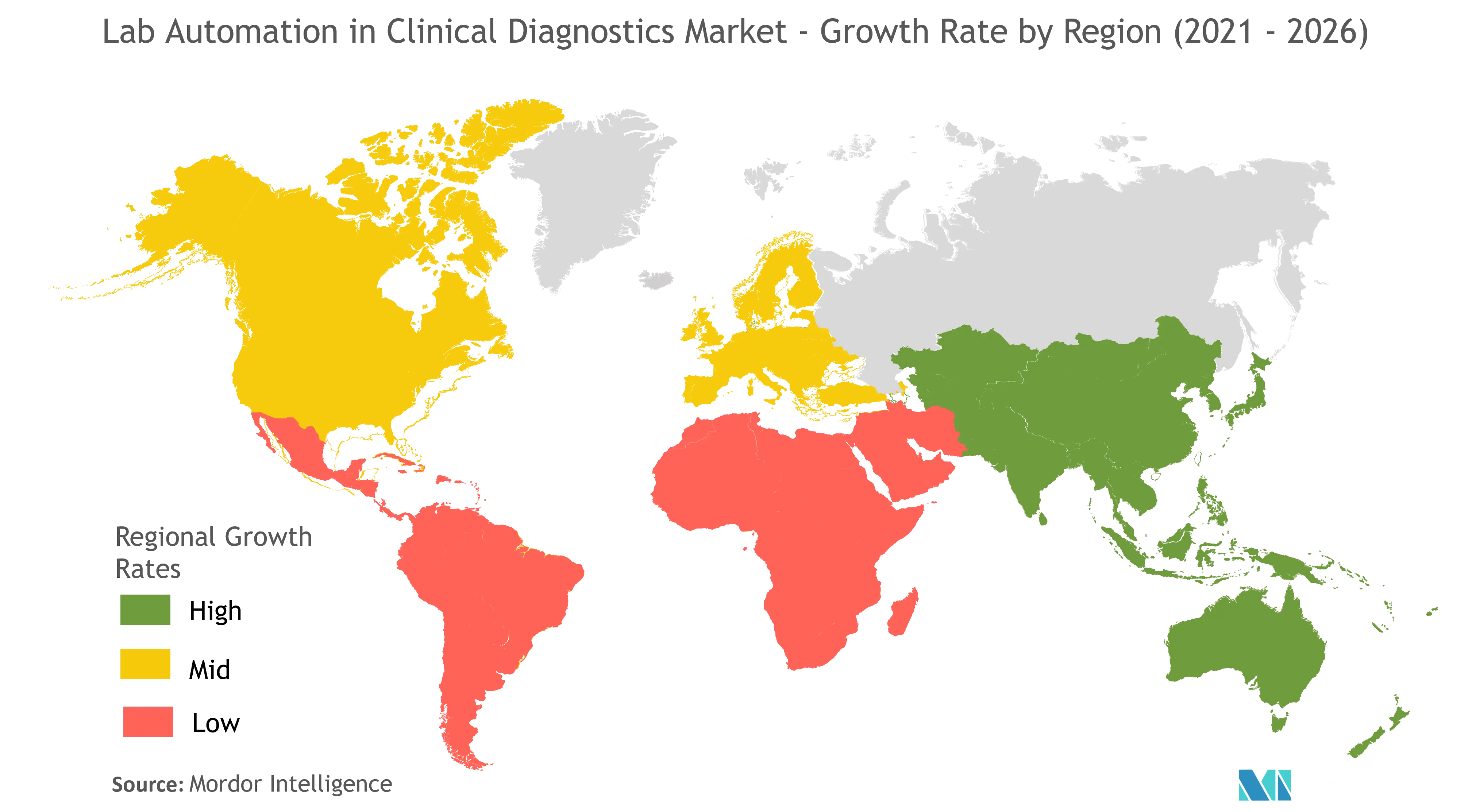
Competitive Landscape
The Lab Automation in Clinical Diagnostics Market is highly competitive owing to multiple vendors providing automation to the domestic and international markets. The market appears to be moderately fragmented, with the significant vendors adopting strategies for mergers and acquisitions, strategic partnerships, among others, to expand their reach and stay competitive in the market. Some of the recent developments in the market are:
- February 2021 - The Thermo Fisher Scientific Amplitude Solution is a new highly automated molecular diagnostic testing system capable of analyzing up to 8,000 COVID-19 specimens in 24 hours. Using the system, laboratories are rapidly scaling their COVID-19 testing workflows to the volumes needed to help reduce the spread of disease and restore economies and communities.
- January 2020 - Hamilton Company announced that its latest automated liquid handling platform, the Microlab Prep, is available through their e-commerce website in the United States and Canada. The compact Microlab Prep provides complete walkaway convenience and effective liquid handling performance in workflows using 96- and 384-well microplates and other sample vessels.
Lab Automation In Clinical Diagnostics Industry Leaders
-
Thermo Fisher Scientific
-
Danaher Corporation
-
Hudson Robotics
-
Becton Dickinson
-
Synchron Lab Automation
- *Disclaimer: Major Players sorted in no particular order
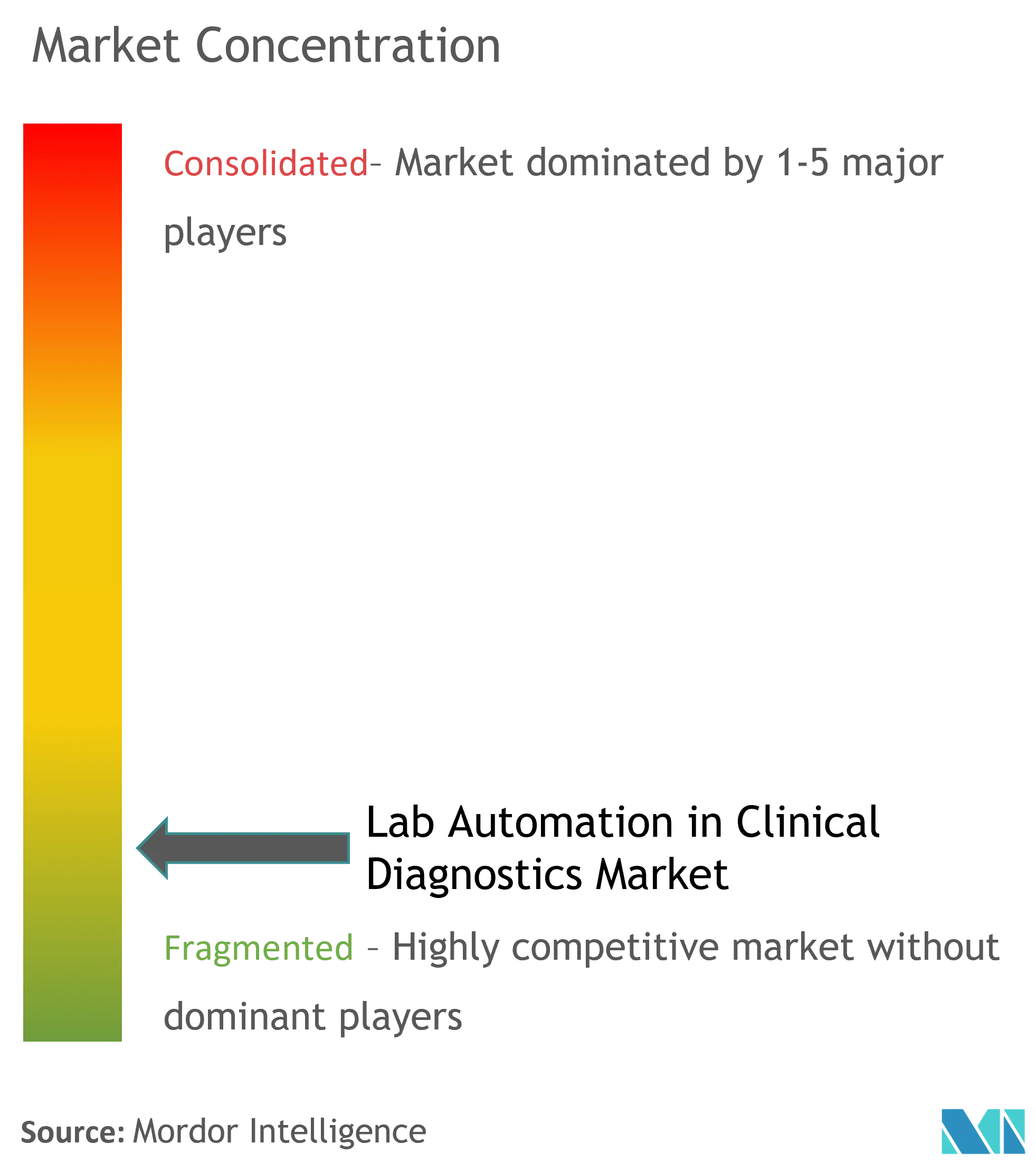
Recent Industry Developments
- March 2021: Roche announced the launch of cobas pure integrated solutions in countries accepting the CE mark. This new compact analyzer combines three technologies on a single platform helping to simplify daily operations in labs with limited space and resources.
- March 2020: Thermo Fisher announced to acquire QIAGEN N.V., where the company plans to expand specialty diagnostics portfolio with attractive molecular diagnostics capabilities, including infectious disease testing. In addition, QIAGEN's instruments can be used to automate these workflows, while its bioinformatics systems provide customers with relevant, actionable insights.
Global Lab Automation In Clinical Diagnostics Market Report Scope
Lab automation in clinical Diagnosis involves using dedicated workstations and software to program instruments to automate routine laboratory procedures. With the advent of technology, automation is now possible in multiplex testing, in addition to activities like microplate automation. Newborn screening is another field where extensive automation combined with software packages to identify complex metabolites is employed. Moreover, the study has been segmented based on equipment type and geography. The equipment types cover automation equipment such as Automated Liquid Handlers, Automated Plate Handlers, Robotic Arms, among others have been considered. The report consists of five regions: North America, Europe, Asia-pacific, Latin America, and the Middle East and Africa. Further, to arrive at the overall market projections, the study analyzes the impact of COVID-19 and the investment scenario and other macro-economic factors.
| Automated Liquid Handlers |
| Automated Plate Handlers |
| Robotic Arms |
| Automated Storage and Retrieval Systems (AS/RS) |
| Vision Systems |
| North America |
| Europe |
| Asia Pacific |
| Rest of the World |
| By Equipment | Automated Liquid Handlers |
| Automated Plate Handlers | |
| Robotic Arms | |
| Automated Storage and Retrieval Systems (AS/RS) | |
| Vision Systems | |
| By Geography | North America |
| Europe | |
| Asia Pacific | |
| Rest of the World |
Key Questions Answered in the Report
What is the current Lab Automation in Clinical Diagnostics Market size?
The Lab Automation in Clinical Diagnostics Market is projected to register a CAGR of 5.60% during the forecast period (2025-2030)
Who are the key players in Lab Automation in Clinical Diagnostics Market?
Thermo Fisher Scientific, Danaher Corporation, Hudson Robotics, Becton Dickinson and Synchron Lab Automation are the major companies operating in the Lab Automation in Clinical Diagnostics Market.
Which is the fastest growing region in Lab Automation in Clinical Diagnostics Market?
Asia-Pacific is estimated to grow at the highest CAGR over the forecast period (2025-2030).
Which region has the biggest share in Lab Automation in Clinical Diagnostics Market?
In 2025, the North America accounts for the largest market share in Lab Automation in Clinical Diagnostics Market.
What years does this Lab Automation in Clinical Diagnostics Market cover?
The report covers the Lab Automation in Clinical Diagnostics Market historical market size for years: 2019, 2020, 2021, 2022, 2023 and 2024. The report also forecasts the Lab Automation in Clinical Diagnostics Market size for years: 2025, 2026, 2027, 2028, 2029 and 2030.
Page last updated on:
